Mark Sisson's Blog, page 222
May 16, 2016
Dear Mark: Higher BMI and Mortality Risk, Calories When Meal-Skipping, HIIT After Fasting
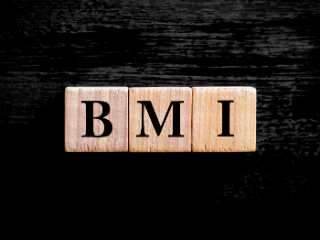 For today’s edition of Dear Mark, I’m answering a couple questions from you guys. First, there’s a new paper out claiming that the ideal BMI for overall mortality is an overweight one—27, to be exact. Is this really the case? Should we all pack on a few extra pounds to see us through into old age? Next, should you try to make up for all the “lost” calories when you eat in a compressed eating window? If you skip breakfast, should you try to eat more at lunch? And finally, how does one incorporate high intensity interval training on a low-carb diet that includes fasting?
For today’s edition of Dear Mark, I’m answering a couple questions from you guys. First, there’s a new paper out claiming that the ideal BMI for overall mortality is an overweight one—27, to be exact. Is this really the case? Should we all pack on a few extra pounds to see us through into old age? Next, should you try to make up for all the “lost” calories when you eat in a compressed eating window? If you skip breakfast, should you try to eat more at lunch? And finally, how does one incorporate high intensity interval training on a low-carb diet that includes fasting?
Let’s go:
Hey Mark,
What do you make of this new study showing that the ideal BMI for mortality is 27, which is overweight? It seems like you hear this a lot, that the slimmer you are, the more you’re actually likely to die young.
Here’s an article about the study: http://www.telegraph.co.uk/science/20...
Thanks!
I don’t think much of it, to be honest.
It was a pretty broad study, the kind that’s been done before. They plotted BMI against mortality in a large cohort of Danes from 1976 to 2013, tracking how the “ideal” (lowest association with mortality) BMI had changed over the years. By 2013, the BMI associated with the lowest mortality had increased by 3.3 points to 27. That’s overweight.
So: start a mass gain protocol, stat?
Before you do that, let’s also look at another recent study on bodyweight and mortality. This one was a meta-analysis of 230 existing studies comprising 30.3 million people and 3.4 million deaths.
The researchers added an interesting and highly relevant wrinkle to their analysis: instead of pooling everyone together, they separated never-smokers and never-smokers without health problems. They also analyzed the effect of BMI on mortality risk in studies with long-term followups. Why do these differences matter?
Smokers tend to be leaner than non-smokers. They also tend to die earlier than non-smokers. Separating the never-smokers from the rest removes those people who are skinny because they smoke. Simply pooling everyone together and analyzing the effect of BMI wouldn’t distinguish between those who were skinny because of or carrying extra weight as a buffer against smoking-related disease.
Separating the never-smokers without health problems takes it a step further. Skinny people who die young are often skinny because of disease or the disease’s treatment. Skinny people who never smoke and have no health problems are a different breed.
Focusing on studies with longer followups gives researchers more data to work with. If you only check back in on your people for five years, you’re going to miss a lot of deaths. It’s not like people stop dying when the study ends. If you follow a cohort for 20 years, you’ll see more deaths—more data points—and get a more accurate picture of the relationship between BMI and mortality.
So, what’d they find?
Among people who’d never smoked, the ideal BMI was 23-24.
Among people who’d never smoked and had no health problems, the ideal BMI was even lower at 22-23.
And when you looked at studies of never-smokers with long followups (20+ years), the ideal BMI was even lower at 20-22.
That’s the polar opposite. Overweight isn’t healthier. If you still aren’t convinced, check out some of my other posts covering similar studies:
Is Weight Loss Impossible and Unhealthy?
Mark,
Love Primal! My question to you is this; When I am skipping breakfast in the morning am I trying to get all of my calories in that 7 hour window from 12 – 7 or am I supposed to cut out the calories from my breakfast that I skipped?
Part of the reason why intermittent fasting/restricted feeding windows works so well is that it leads to inadvertent calorie reduction. When you don’t eat an entire meal, it’s hard to make up for it.
Eat when hungry. Stop when full. Most studies find that breakfast skippers are hungrier at lunch than breakfast eaters, but they don’t actually eat enough to make up for the calories they missed at breakfast. This is good. This is why skipping the occasional meal tends to improve weight loss. It makes eating less easier.
Unless you’re trying to gain weight, you don’t need to force more calories down. It’s not like you’re running on empty just because you didn’t eat breakfast. You’re still burning energy, burning “calories.” And once you get fat-adapted, a process which fasting tends to accelerate, you tend to get that energy from your body fat. You aren’t missing any calories. You’re just getting them elsewhere.
Dear Mark,
I am a 52 year old menopausal woman. About 3 years ago, I lost 25 pounds with intermittent fasting and have kept it off. At 5’3″ tall, I currently weigh 125 pounds. Despite this, I have been diagnosed with insulin resistance and at the urging of my doctor, I began eating a very low carb diet about a year ago. Most days, my carb intake is easily under 40g with most of that coming from veggies and the occasional glass of red wine. I don’t eat sugar or grains and limit any artificial sweeteners.
So I recently heard about how great HIIT is for improving insulin sensitivity and I would like to incorporate it into my exercise routine (which now consists mostly of walking and some body weight exercises). I’ve done one session on my stationary bike that consisted of 20 seconds intense peddling and 2 minutes rest x 3. At the end of this, my legs were so shaky, I could hardly stand. This was after an overnight fast of about 16 hours. In your opinion, should I be eating before a session? Since I eat so few carbs, I don’t want to “carb up” before…is there any need to? Or is it completely normal to be that totally spent, given that I am just starting?
Also, after the session, my blood glucose level took a pretty big jump…probably about 30 points. Just trying to understand the physiology behind this.
Thank you for your time!
Congrats on your weight loss!
Did you ever read the post about “sleeping low“? It went up a couple months back and I’d recommend it.
In short, doing a big HIIT session after a long fast on low-carb is really tough. Your glycogen stores will be depleted (from lack of carbs in the diet and from not eating for the past 16 hours), so you won’t have a lot. That’s why your legs were shaky.
A better option is to eat a small dose of carbs before the HIIT workout. Remember that green veggies don’t really contribute to your carb intake. They provide fiber, micronutrients, phytonutrients, but very little usable glucose. You’re not gonna refill glycogen with broccoli and Swiss Chard, so instead eat a potato (maybe cooked and cooled for increased resistant starch), a banana, some mango, or maybe a bowl of berries. Something starchy and Primal to the tune of 30-40 grams of carbs.
After your HIIT session, eat low-carb until your next one. You’ll have depleted most of your glycogen during the workout, so you’ll be primed to burn fat. As long as you’re truly just walking and doing some body weight stuff, you can probably get by with just that small bolus of starchy carbs once a day or whenever you do something intense.
As for the blood glucose spike, that’s normal since sprinting is a particularly glucose-intensive activity. It burns right through muscle glycogen. Sensing this, the liver releases glucose to provide additional fuel for the body; in healthy people, type 2 diabetics, and type 1 diabetics alike, blood glucose spikes after most any exercise, but especially after sprinting. Long term, sprinting will improve glucose control.
That’s it for today, folks. Any follow up questions of your own? Let me hear them in the comments below.




May 15, 2016
Weekend Link Love – Edition 400
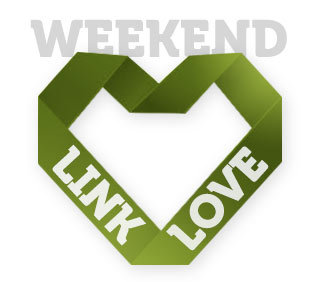
I recently dined with the guys at Power Supply. Check it out along with their recipe using PRIMAL KITCHEN™ Mayo.
Speaking of mayo, how about a year’s worth in exchange for your Success Story?
Plus, a whole host of free Primal Kitchen products could be just one “like” away.
Research of the Week
Nitrate rich vegetables (beet juice, spinach smoothie, rocket salad) reduce blood pressure more than sodium nitrate. Obese women vigorously exercise for an hour a year. Obese men, 3.6 hours. Cause, effect, or both? Either way, it’s a sad state of affairs.
We’ve got a sixth sense that protects us during distracted driving, but not if we’re texting.
A barefoot run enhances working memory.
Animism was the earliest religious belief.
Use of artificial sweeteners during pregnancy is linked to heavier babies.
A new study finds no link between cell phones and cancer.
Researchers have detected evidence of significant genetic shifts in the human genome in the last 2000 years.
New Primal Blueprint Podcasts

Episode 119: Chris Adams: Host Brad Kearns hangs out with firefighter and PrimalCon legend Chris Adams about the importance of stress mitigation, balancing training with the stress and sleep-deprivation inherent to firefighting, what it takes to make it as a firefighter in Arizona, how (and why) to slow everything down, and much more.
Each week, select Mark’s Daily Apple blog posts are prepared as Primal Blueprint Podcasts. Need to catch up on reading, but don’t have the time? Prefer to listen to articles while on the go? Check out the new blog post podcasts below, and subscribe to the Primal Blueprint Podcast here so you never miss an episode.
How to Stop Using Food Like a Drug
13 Worthy Alternatives to Traditional Sprinting You Should Try
Why Grok Didn’t Have to Floss But You Do
Interesting Blog Posts
The most effective blue-blocking eyewear is the cheapest.
These would be cool to blow up and have on your wall: periodic tables of kettlebell, dumbbell, bodyweight, and TRX suspension exercises.
Media, Schmedia
Kids in some areas need notes from their doctors just to keep recess.
Taubes proposes a better Big Fat Loser study.
Everything Else
Good news! No need to eat liver, leafy greens, or pastured eggs. You can get all the folic acid you need in a bag of Fritos!
The (often terrible) power of “no.”
Bread sales plummet across the UK.
Health and infectious disease experts are urging the cancellation of the 2016 Olympics in Rio for fears it’ll spread Zika worldwide.
Did the potato change the world?
DIY China Study (very cool).
Recipe Corner
Make the perfect poached egg.
Lamb ribs (one of my favorite yet underutilized cuts) with rhubarb.
Time Capsule
One year ago (May 18 – May 24)
Is Raw Milk Really Better? – Short answer: probably, but it depends.
15 Alternatives to Burpees for When You’re Tired of Doing Burpees – Quick, effective exercises you can do in a small space without much equipment.
Comment of the Week
“100% of the psychology students were experiencing anxiety … ironic in a sense. :)”
– Indeed, HealthyHombre.




May 14, 2016
Whole Roasted Green Curry Chicken in Coconut Milk
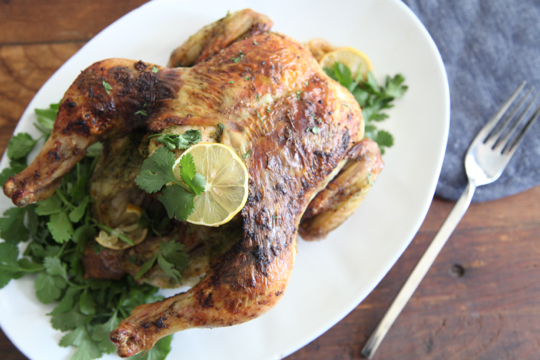
It’s easy to be intimidated by recipes for homemade Thai curry paste, what with the long list of sometimes hard-to-find ingredients and all. So this recipe keeps things as simple as possible, using a slightly modified list of ingredients that can be found in most grocery stores. Throw all the ingredients into a food processor, blend until smooth, and in a few minutes you’ve got yourself some homemade Thai green curry paste.
Bright, vibrant, and aromatic, homemade curry paste hits all the senses. Packed with flavor and made from superfoods like garlic, ginger and peppers, curry paste is a remarkable condiment.
This recipe slathers a whole chicken with the magic green sauce. Roasted in coconut milk, the chicken is succulent beyond compare. The coconut milk turns into a rich sauce for the cooked chicken, and also keeps the meat moist as it cooks.
Servings: 4
Time in the Kitchen: 30 minutes hands-on, plus 60 to 90 minutes to cook
Ingredients:
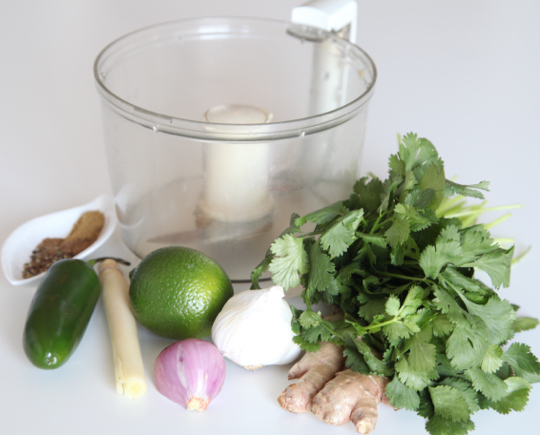
1 whole chicken, patted dry and seasoned generously with salt
8 peeled cloves garlic, divided
1 stalk lemongrass, outer layer peeled off, thinly sliced
1 or 2 green chilies, seeded and chopped (jalapenos can be used in place of Thai green chilies)
1 shallot, thinly sliced
2-inch piece ginger, peeled and sliced (5 cm)
1/2 cup loosely packed cilantro leaves & stems, roughly chopped (120 ml)
1/2 teaspoon ground coriander (2.5 ml)
1/2 teaspoon ground cumin (2.5 ml)
1/4 teaspoon ground pepper (a pinch)
2 tablespoons fish sauce (30 ml)
1 tablespoon fresh lime juice (15 ml)
1 (13.5 fl ounce/400 ml) can coconut milk, divided
1 small lemon, thinly sliced
Instructions:
Preheat the oven to 400 °F/204 °C.
In a food processor, blend 4 cloves garlic, lemongrass, green chilies, shallot, ginger, cilantro, ground coriander, cumin, pepper, fish sauce, lime juice, and 3 tablespoons coconut milk into a smooth paste. The coconut milk is added to help the ingredients form a paste, so add a little more if needed.
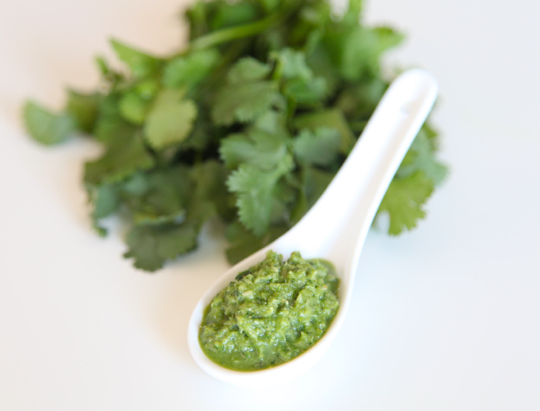
Rub the seasoned chicken down completely with the curry paste, over and under the skin. If you have extra curry paste, spoon it into the chicken cavity.
Heat a Dutch oven (or other ovenproof baking vessel that is slightly larger than the chicken) over medium heat. When the pan is hot, add a few tablespoons avocado oil or coconut oil. When the oil is hot, add the chicken, breast side down. Cook 4 to 6 minutes, browning the skin. Carefully flip the bird, browning it a few minutes more.
Pour the remaining coconut milk around the chicken. Use a rubber spatula or wooden spoon to scrape up any browned bits stuck to the bottom of the Dutch oven. Add the remaining 4 garlic cloves and the lemon slices to the coconut milk.
Cook, uncovered, 60 to 90 minutes until the chicken is cooked through. When an instant-read thermometer inserted into thickest parts of the chicken reads 165 °F, the chicken is done.
Serve the chicken with the pan sauce spooned on top.

Not Sure What to Eat? Get the Primal Blueprint Meal Plan for Shopping Lists and Recipes Delivered Directly to Your Inbox Each Week. Now Available as an App!



May 13, 2016
Reclaiming My Health—Mentally, Emotionally, Physically and Spiritually
It’s Friday, everyone! And that means another Primal Blueprint Real Life Story from a Mark’s Daily Apple reader. If you have your own success story and would like to share it with me and the Mark’s Daily Apple community please contact me here. I’ll continue to publish these each Friday as long as they keep coming in. Thank you for reading!
 My physical health has been pretty good most of my life—I had surgery to attempt to correct strabismus (my eye muscles don’t work well together) twice when I was an infant. I’ve had very few injuries and illnesses, thankfully. My MDA miracle is much more oriented on the mental and spiritual health level.
My physical health has been pretty good most of my life—I had surgery to attempt to correct strabismus (my eye muscles don’t work well together) twice when I was an infant. I’ve had very few injuries and illnesses, thankfully. My MDA miracle is much more oriented on the mental and spiritual health level.
I was always very squirmy and full of energy, and my restlessness surely got me into some trouble growing up. Even as an adult sitting still was incredibly uncomfortable until 2011, when I began the Primal lifestyle. I was tested and given therapy and medicated as a child to try and address my behavior and imbalance, and came to believe I would be medicated for the rest of my life. In truth, I was grateful for the changes the medication brought about once we found an effective combination and dosage, though the experimenting was difficult.
Due to my eyesight and lack of depth perception, I generally consider sports that use balls as cruel. I didn’t engage in sports or stick with any extra-curricular activities until my junior year of high school when I joined the swim team, and though not as regularly or rigorously, I still swim today. Looking back, I believe that not having a good outlet for my excess energy contributed to some of my behavioral issues, but there was no lack of trying on my family’s part—it was just that nothing stuck until swimming.

I’ve always been tall with long legs and arms, though also quite clumsy. At my heaviest I weighed over 180 pounds. I used to sleep a solid 12 hours every weekend and I drank coffee to try to maintain energy levels throughout the day. I grew up on boxed macaroni and cheese, occasional canned veggies and wonder bread. I put on the all too common “freshman 15” at college, and then some. Once on my own, I began to eat healthier, though still subscribing to the SAD (primarily grains). I found cooking or working with fresh food to be intimidating and annoying, and so I mostly ate pre-packaged frozen food.
In 2010 at the age of 26, I began to make some real changes in my life. I decided to stop drinking and smoking, and I began taking a yoga class. I met my husband-to-be and we reveled in our Monte Cristo sandwiches and takeout pizzas. Brimming with delight and new love, we were carefree with our extra pounds, and though neither of us was entirely negligent of our health, we did not have any real focus or approach to improving it.
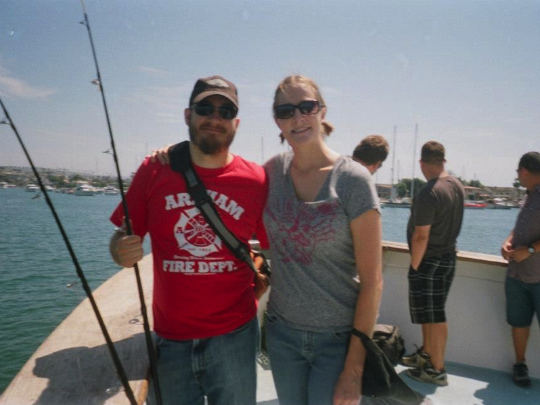
In the Fall of 2011, a friend called to tell us how she had found a new way of eating, and living, that had profoundly changed her life. She specifically mentioned that after transitioning, she had been able to cease taking medication for her mental health. She told us that it wasn’t a diet and it wasn’t focused on deprivation or counting calories. We were intrigued and decided to read about it. She sent us straight to MDA.
After cruising the blog for a day or two, I was hooked and ordered The Primal Blueprint. Together, my husband and I read and discussed it, and agreed to give it a try. We cleaned out our pantry together and began preparing for our carb-flu, our stomachs anxious at the thought of letting go of staples like bread and cereal.
Learning this whole new way of identifying with food somehow opened me up to try cooking, and we began purchasing fresh food and even found a local farm for grass-fed organic meat. For the first few months I made “breakfast bars” from nuts, berries and shredded coconut to help wean us off our expected grain-filled breakfasts, and we slowly introduced more eggs and Primal fare. We began shopping at our local farmer’s market weekly as well. The online community had so many great recipes to choose from, and we had a lot of great successes! We found new things we didn’t know we’d ever like, and a few that we are still not overly fond of.
In the beginning, I tracked my carb intake to help learn about the content of what I was eating. I was so surprised at how many things were sweetened! We did indeed have the carb flu, though we persevered. I had some issues with migraines and my doctor advised me to try to cut back on caffeine, so I stopped drinking coffee.
Within a month we saw results. I began to wake up earlier and earlier on weekends, no longer taking my expected 12 hour rests. Our energy was more consistent throughout the day. We focused on the little things with exercise—walking more, parking farther away, and I committed to yoga and swimming sessions. I have dabbled in the Primal Fitness programs- sprinting and doing isometric exercises, though they have not been a consistent part of my story. I also have a standing desk at work that allows me to alternate between standing and sitting during the day. Often I eat lunch outside in the sunshine and breeze.

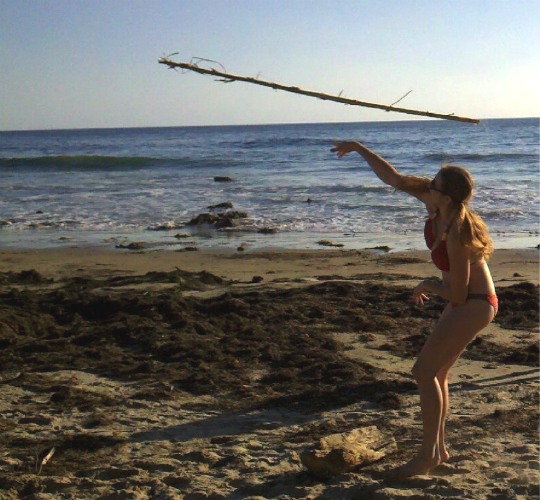
In our first months of transitioning, inches began to melt away and we found great happiness and satisfaction with our food. At my leanest I was down to 155 pounds, and my husband was down from over 200, to 180. We experienced a shift in our tastes as we were consistent with our minimizing of sugar and grains. Very dark chocolate (85%+) and berries were plenty sweet, though admittedly we did a lot more “primal baking” in the beginning than we do now! We began to find the art of eating out and eating while traveling. We found what restaurants we can frequent easily and bought a dehydrator making our own unsweetened dried fruit and beef jerky.
My absolute favorite change we went through is that my husband’s snoring decreased dramatically!
As far as what didn’t work, I would say the Primal Fitness program. I have found my own balance of moving slowly and often—walking, taking the stairs, tightening my abs randomly, and swimming and yoga. The sprinting and lifting heavy things just don’t come into play as often. I garden and have a saltwater fish tank that involves hauling 30 lb jugs of water every couple weeks, but I never bought weights or any of that. If I was unhappy with my strength or muscles, I would try harder to incorporate these things.
To be honest, I don’t think I could have succeeded it if I lived with someone who kept bread and cereal and cookies and chips in the house. When we have easy snacks like coconut flakes and yogurt, I always eat those first. Having a clean fridge and pantry enforces my clean eating. When my husband brings home gluten-free bread, I have him stash it where I can’t see it so that I forget it is there and am not tempted.
Potatoes/starchy veggies are often controversial in the Paleoshpere. We eat yellow and orange sweet potatoes (or yams, or whatever) occasionally and even a bit of chicken fried rice here and there. We try to stay aware and balance our intake, and stay conscious of getting those hearty greens daily.
We told our family and friends about our journey, and I even gave out a mini-cookbook of my favorite recipes for Christmas. We converted a few friends who have their own marvelous success stories. Over the years we have found a great balance where we can observe our own swings where we push the 80/20 rule too hard and need to “reset.” The more we stray, the more we crave. We have learned that if we want pancakes, we go share a big pancake. If we want cheesecake, we go have a slice of cheesecake (make it great quality!), rather than trying to make Primal versions of these things. We keep our treats spread out when we can, and I have definitely had my share of sugar hangovers (usually holidays or traveling) when I wake up groggy and headachy and crave sugar with a vengeance for a few days.
Our weight and size have fluctuated some, though we have never owned a scale. We can keep a pretty good eye on how we feel and how our bodies are responding. I’ve not gotten above 175 since going Primal and I usually sit around 165. My blood work continues to show very low risk for coronary issues though it reports both my good and bad cholesterol are high, but there is plenty of information out there about interpreting cholesterol results! I used to worry about too much fruit, but I’ve seen that a banana and an apple every day is just fine for my body. I am also fortunate that dairy has not been an issue with me, so I enjoy the delights of milk and cheese regularly as well.
We only shop at health food stores these days. Between farmer’s markets and CSA’s, we just can’t find the quality of food we want at traditional grocery stores. Of course it is more expensive, but it is an investment to our health, and we consider it well worth the cost. We generally follow the dirty dozen for what produce we buy organic, and we are careful with the food we grow (using peppermint castile soap mist for pesticides, etc).
Another noticeable change was how often (or how rarely, I should say) I get sick. I used to catch a cold or cough a few times a year, and now it isn’t uncommon to go a year without anything at all.
After a solid year of living Primal, I decided to take the plunge and spoke to my doctor about eliminating the anti-anxiety medication that I had been on for 13 years. I weaned off slowly, and found to my delight that with exercise, sleep, play and healthy fuel for my body, my mind was able to maintain a chemical balance. This was a great relief, and I believe it to be a powerful testament to living a new lifestyle. What started as a pantry clean out has become daily habits and redefined approaches, outlooks and overall attitudes. The heart of my success isn’t about before and after photos that blow you away, or my waistline, or how much I can bench press. The heart of my story is about my health—mentally, spiritually, emotionally and physically.
The Primal lifestyle is about so much more than how you look and what you eat. I brought play into my life and gave it high priority. I go on barefoot hikes and walks, I bask in the sun, I do yoga and meditation daily. I’ve even become a certified yoga instructor. I eliminated toxins (including toxic relationships) from my life. I have been shamphree since 2011 (I use the baking soda and ACV method), and we use Dr Bronner’s soap for all but the greasiest of dishes. I make my own deodorant with coconut oil, and we use soap nut concentrate for our laundry. We buy toothpaste with little or no sweetener. We try to use microfiber cloths and eco-friendly cleaning products as well. I began wearing minimalist shoes when I went Primal, and have had great success with that (though I’ve yet to buy my first pair of toe-shoes!). We also transitioned our pets to a paleo diet, and they both happily live on high quality grain-free food. We cut down on waste and paper products through such practices as using cloth napkins and reducing our use of paper towels. Even our wedding did not have cake or alcohol, instead, we served homemade mulled apple cider and chocolates crafted by my father.
We bought our first home a year ago, and the first thing we did was turn off the sprinklers so we could replace the grass. I am more in tune with nature, and I know how healing it is. Primal living (as well as some of my upbringing) taught me to love the earth under my feet and the sun and breeze, and I wanted to make our outdoor space sustainable and enjoyable. We tore out that grass by hand and xeriscaped it with drip irrigation. We put a patio in the back for lounging and garden beds for organic vegetables. We have a compost bin and hope to get some chickens someday!
Living Primal encouraged me to be more prepared and self-sufficient. I wish there were boy-scouts for adults where we could learn first aid and wilderness survival skills. Regardless, I now have 72 hour emergency kits for travel and hiking, as well as packs in the house and each car with the standard provisions, and I stay CPR certified. I made a bucket list a while back and backpacking and horse riding were on it, and I am fortunate enough that last year I went on a pack-trip in the Sierras with a dear friend and some of her fabulous mules and horses. We slept under the stars, skinny dipped in a mountain lake, and cooked tri-tip over the fire.

Every now and then my husband or I have that nostalgic curiosity about something like a Dr Pepper, but it is usually repulsive to our current tastes. On the other hand, we have had chicken and waffles or red velvet cake that was truly decadent. A general rule that has helped me with my previously insatiable desire for sweets, is that I can reach the top of the satisfaction bell-curve with a shot glass sized portion of any sweets. Does more than that still taste good? Of course! But is usually is accompanied by consequences such as discomfort, guilt or that dreaded sugar hangover. Without juice, soda or alcohol, I’ve found great variety and satisfaction with sparkling water and tea. We’ve even put a dash of cherry balsamic in our sparkling water beyond just the standard lime wedge.
TMI Detail: One of the most obvious and profound things we noticed when we switched our dog’s food was the consistency, color and quantity of his waste. I know this is TMI, but when we lived in an apartment with a little cement patio, all potties were done on walks, and so it was easy to notice this. It can similarly be observed for us as well—when we eat crappy, we crap crappy and can often experience indigestion, bloating and gas.
TMI Detail #2: Being Primal encouraged me to be more in touch with my body. I read a book on fertility (not out of any interest in pregnancy, but as referred by a friend) and I learned so much about my own body that I was never taught before (basal temp shifts during ovulation and menstruation, cervical position and fluid changes, etc). This more intimate knowledge of how my own body works allows me to feel less threatened or fearful when I experience changes. Health isn’t only about the doctor saying you are good to go, but about knowing your OWN body and being able to identify what being healthy FEELS like to YOU.
Lessons learned/tips: If you have any challenges—mental or physical—I recommend eating clean for 30 days (Whole30 or strict paleo). Cut out all those common offenders like gluten, grains, sugar and dairy and see what changes you experience. Yes it will be challenging, but it is worth it. You can introduce them back one at a time and potentially find a solution to what was previously thought of as a “chronic” issue! Why wait? Don’t let fear hold you back – feeling good is worth it!
Snacking: I often crave crunchy snacks, and I’ve found dehydrated zucchini chips, carrots and celery or raw almonds to do well for this.
Hunger: If I don’t want an egg or some turkey (protein or veggies), then I am probably not actually hungry. I try to have some tea instead. Eating Primal doesn’t always address the AMOUNT I eat—“I can have as much meat and veggies as I want!” she says, holding an aching stomach. I am working to be more aware of WHY I eat—is it boredom, comfort, habit?
Fast Food: Sometimes I need to eat out on a tight schedule. I have found Chipotle (burrito bowl with no rice) and In-N-Out protein style burgers (skip the fries) to be my go-to fast food places.
Traveling: Most of the time I can find a place along the way with salads or sandwiches I can take apart. For hotels, I seek those with hot breakfasts so that they will at least have eggs. I bring meat bars (as opposed to nut and date bars, as those are more of a dessert for me). Nuts also travel well. Most hotels will provide a mini-fridge if you request it for medical purposes as well.
Eating Out: Be fearless. Say “No thank you” when they bring that basket of bread. Swap veggies for fries. You are paying to be fed, so get what you want. You can always express your gratitude with your tip!
Pro-tip for Shamphree Travelers: Carrying a bag of white powder and a bottle of urine colored substance can be very suspicious. Even labeling them “baking soda and apple cider vinegar” might seem off, so often when I fly I just use hotel shampoo and conditioner!
Sleep: I now have a white noise machine, an eye mask and earplugs. I get in bed earlier and allow myself to transition to sleep. I’ve never suffered from insomnia or difficulty sleeping (I am just a very light sleeper), but I have been known to get lost in the rabbit holes of my digital devices before bed, so I try to put it down and turn off the lights at a good time!
Costco: We get some great stuff from Costco – coconut oil, organic ground beef, sliced almonds, organic chicken, almond butter and more!
Favorite Recipes: Coconut milk pops (1 can of pumpkin puree, 1 can of coconut milk and cacao nibs in a popsicle mold). Stovetop carnitas and bacon pecan Brussels sprouts. Runner up—beef stuffed butternut squash.
It’s been about five years now and I am still going strong, though my husband was varied and has dabbled in pescetarianism and ended up generally following the Mediterranean diet (through no failure of Primal—instead it was a decision based on ethical preferences). I have some staples that I eat regularly and some favorite recipes that I rotate around. I like to cook big and freeze individual portions for later meals. I usually do a Big Ass Salad for lunch and we keep 90% Lindt chocolate stocked at all times. I like frozen berries with cream and cacao nibs for a treat. Frozen banana slices are big hit as well. I feel balanced and healthier than I ever did before. I feel strong and capable, confident and full of energy. I no longer consider myself clumsy, and my overall happiness and satisfaction with life is fantastic. I face life’s challenges with optimism, though that isn’t to say I never break down or have a hard time.
Veronica







May 12, 2016
How to Have a Civil Discussion About Divisive Issues
 I made the decision long ago to slash my media intake, and I’ve never looked back. It’s not that I abstain entirely. Since my chosen professional and family obligations meant I never had a ton of time for it to begin with, I simply became much more selective. In particular, I had no patience for the irate, drama-inducing screaming matches that had begun taking over the airwaves. For years now people have bemoaned the coarsening of public discourse (and with it, general behavior), and experts have been analyzing its cause. Jonathan Haidt in his book, The Righteous Mind, is a clear example. How did we come to a place of perpetual mouth foaming? While I won’t delve into that particular swamp, I will take up the flip side of that coin today, which has been on my mind lately (maybe on many people’s minds). What primal principles can help us remember how to have a civil discussion about divisive issues?
I made the decision long ago to slash my media intake, and I’ve never looked back. It’s not that I abstain entirely. Since my chosen professional and family obligations meant I never had a ton of time for it to begin with, I simply became much more selective. In particular, I had no patience for the irate, drama-inducing screaming matches that had begun taking over the airwaves. For years now people have bemoaned the coarsening of public discourse (and with it, general behavior), and experts have been analyzing its cause. Jonathan Haidt in his book, The Righteous Mind, is a clear example. How did we come to a place of perpetual mouth foaming? While I won’t delve into that particular swamp, I will take up the flip side of that coin today, which has been on my mind lately (maybe on many people’s minds). What primal principles can help us remember how to have a civil discussion about divisive issues?
Sure, vitriol isn’t a new phenomenon. Human history is riddled with grave examples of hateful speech and its consequences. Still, it’s interesting to hear fuming behavior described as “caveman” or “uncivilized.” Is this a fair way to look at it? Were Grok and his kin really rock-throwing brutes, or would they likely show up us “moderns” in their adherence to relative order and harmony? In other words, how much is civility really dependent upon civilization?
What would Grok really do in the midst of dissension? From what we can ascertain, there was likely more inter-band flux than there was intra-band fighting. If you weren’t happy with how things were going in one group, you had the choice of moving to another. But if the problem was your own hotheadedness, you’d likely be called to account at some point. When daily survival was at stake, disunity wasn’t a workable option.
As a result, bands lived elaborate codes that prioritized the harmony of the group. Social structure was egalitarian. Conflict was settled within the group with a mind toward traditional order, historical precedent and cultural/cosmological principle.
Among the in-depth observations of recent historical hunter-gatherer groups, it’s been noted that such egalitarian groups took great time in making decisions that might raise conflict or otherwise divide the group. The process by which a decision was made was treated as more important than the ultimate decision itself. Members casually mentioned personal impressions with no immediate response rather than wrangle ad nauseam over their insisted beliefs.
It’s an intriguing model for considering everything from assessing leadership to deciding life changes, from discussing health issues to fielding criticisms of our Primal choices.
With this model in mind, let’s lay out some principles for civil conversation.
Tune out the extraneous emotion
The old, milquetoast proposal, “Why don’t we all just calm down?” might seem like a tricky suggestion when divisive issues are on the table, but behavioral studies suggest present moment anger can exacerbate our perceived polarization of viewpoints. Anger feeds division—probably not a crazy claim, given its power in battle cries across all centuries and regions.
Ask what mindset and emotion you’re bringing to a discussion, and be aware of what others seem to bring to it. Know there’s a time and place, and that means not when folks are whipped up about any manner of issues.
Assess the importance of proving your point
We’re not talking here about following what you believe—we’re talking about making other people buy into it, too. Are you really so committed to convincing everyone that grains are unhealthy that you’ll sacrifice relationships within your family to do it?
Do we really need everyone around us to be of the same mind on any given issue, including primal health? Can we learn to stand in our own beliefs without demanding others change for us or even understand why we think what we do? In all but the most dire and direct survival circumstances, Grok would’ve put group unity above personal agenda.
Speak solely for yourself
We all remember at some point hearing about “I statements”—ways of phrasing our opinions as our personal beliefs rather than universal truths. If you tell friends at dinner that their thick-soled or heeled shoes are ruining their postural alignment, that’s different than sharing how wearing minimalist footwear has made a difference in your back pain and racquetball game. (You’ll also probably have a better time that night and get invited again next time.)
Likewise, drop any group identification, which only fans the flames of outrage. Accept that this discussion is about the other person(s) present, and that’s it. When we converse as individuals, we can still relate as people. When we converse as representatives of groups, it’s all too easy to dehumanize the other.
Even if you’re operating from science, and the other person is grasping at straws, you’re better off saying that what you read about x, y and z helped convince you to make certain choices, rather than arguing about what the other person needs to do. Promote your success rather than dictate the other person’s behavior.
Make a personal commitment to equanimity
Research demonstrates that even when we acknowledge a degree of uncertainty about a belief or choice, we are likely to lock into our position if we feel emotionally threatened by the attitude of the other.
People don’t respond well to dominance or threat, and some people have a hair trigger for these perceptions. (I’m sure we all can identify some of these people now.) If your agenda is to make someone angry or defensive, then by all means come off subtly or overtly as threatening their intelligence, intentions or integrity.
If, however, you want to actually be heard, commit to keeping your cool regardless of their mood. There’s nothing more powerful than disarming a person’s hostility with your own self-possessed example.
When appropriate, appeal to sadness and tragedy
Researchers have affirmed what I think we all can intuit—tragedy brings us together, and sadness encourages mutual identification, problem-solving and support. It’s important to note that the crux of this appeal is shared feeling—not directed blame. Whether you’re talking about health issues, family conflict or social concerns, focus on what happened and what positive steps can prevent additional hurt, damage or loss.
Give the conversation space
Hunter-gatherers weren’t in the big fat hurry we all are today. As in the aforementioned decision-making example, they knew how to exercise patience. Learn to see persuasion as a gradual, dynamic, interactive process rather than single-session business.
Reframe your agenda as sharing your experience and planting a seed in the other person’s psyche. Persuasion isn’t equivalent to submission.
Let your life be your statement
You can’t really talk about discussing divisive issues without hitting up against the question, “Does it really help to even discuss it at all?”
Sometimes we don’t have a choice. We’re navigating a work or family issue that can’t be swept under the rug. Other times, however, it’s a subject we can realistically let go.
Even (and maybe especially) if you consider yourself a lifelong debater or activist, ask yourself how much time and energy you are willing to give a particular conversation. Base this assessment on the likelihood that you’ll get what you’re gunning for. (And then ask if getting that will result in any real gain or if it’s more an exercise in control.)
The thing with time and energy is this: you don’t get them back. Sure, there’s another hour and eventually another surge of stamina—but not the ones you’ve already given away.
It may be my later years talking here, but I tend to think people often do well by conserving their time and energy more for their own commitments than they do surrendering them to move other people in their direction. Not only do you enjoy the chance to actually accomplish something tangible with that parcel of time and energy, but you’ve also preserved something of your own peace and sanity by forgoing the Sturm and Drang of conflict.
At issue here is the thoughtful—and increasingly rare—distinguishing between effective persuasion toward a measurable and meaningful result and indulging in high emotion for its own sake.
When we focus too much on other people and demand their adherence, action or even understanding as a condition for our own happiness, we’ve set ourselves up for misery and disappointment. Why impose that on ourselves?
The most civil thing we can do—for ourselves and others—is often to discern what needs to be addressed and what doesn’t. There’s an essential humility and perhaps primal astuteness in learning to be selective. Our ancestors had a better understanding of what was worth getting one’s dander up about because there was less room for ire (and error) in their world. Perhaps if we redefine our priorities today, we might find the same for ours.
Thanks for reading today, everyone. I’d love to hear your thoughts on keeping discussions civil even around thorny issues. Have a great end to your week.




May 11, 2016
10 Ways to Treat Burnout (and How to Avoid It Altogether)
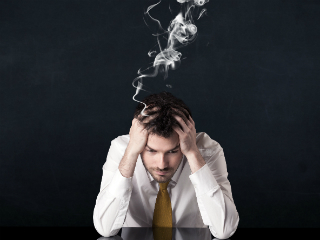 This year it was all over the headlines that what we typically call “burnout” just might be depression. Beyond the vagueness such wording introduced (another way to push anti-depressants?), the actual research further affirms burnout as a genuine psychological and physical experience. The study confirmed that those who suffer from job “burnout” also experience the onset of key depression symptoms, something of little surprise to anyone who’s ever been through it. Yet, as an earlier study suggests, burnout is its own animal. Symptoms are largely linked to “atypical” depression, which behaves differently and can more readily suggest situational origins. It’s something I’ve been saying for years—certain elements of the modern (unmitigated) experience promotes neurosis more than we’d like to admit. Burnout is one common example.
This year it was all over the headlines that what we typically call “burnout” just might be depression. Beyond the vagueness such wording introduced (another way to push anti-depressants?), the actual research further affirms burnout as a genuine psychological and physical experience. The study confirmed that those who suffer from job “burnout” also experience the onset of key depression symptoms, something of little surprise to anyone who’s ever been through it. Yet, as an earlier study suggests, burnout is its own animal. Symptoms are largely linked to “atypical” depression, which behaves differently and can more readily suggest situational origins. It’s something I’ve been saying for years—certain elements of the modern (unmitigated) experience promotes neurosis more than we’d like to admit. Burnout is one common example.
Most people have experienced brief phases of it. Others have unfortunately found themselves in the long-term grip of it. Burnout is that bottomed out sensation of emotional and often bodily exhaustion. We feel wholly knocked down by the unrelenting demands or psychological disorientation of our circumstances. Eventually, we feel we just can’t get up again. The result can be a hollowed-out, hopeless, automaton feeling. Some people cry at random. Others shut down. We might still be moving through our duties at home or work, but it’s often with a numbness that hovers above a perpetual anxiety or emptiness.
Still, it’s important to understand that we’re not talking about “just” a psychological phenomenon here. Burnout, while it’s the long-term result of outer circumstances rather than inherent genetic workings, is still very much a physical malady. Primary symptoms include the aforementioned physical and mental exhaustion but also, commonly speaking, insomnia or sleep disturbances, slow mental processing, impaired memory, irritability, reduced concentration, impatience, cynicism, unexplained pain or headaches, and appetite changes. This is no figment of the imagination.
We mostly hear about burnout in terms of work, as in job burnout. That’s the case with the aforementioned studies (which followed teachers), but I’ve seen burnout in people who either don’t have standard jobs (e.g. parents who stay home with children) or who do have regular work but whose burnout is clearly rooted in other long-standing factors such as intensive parenting or other caregiving demands, acute health/fitness obsession, chronic marital conflict or family dysfunction. The primary issues in these cases are basically the same as those noted in job burnout: lack of life balance, dysfunctional dynamics, unclear or unreasonable expectations, inadequate social support, and perceived lack of control.
While the lives of Grok and his kin could certainly be described as hardscrabble and at times unpredictable, there wasn’t such a thing as chronic stress in the way we know it today. Acute crisis existed for sure, but conditions didn’t promote chronic tension. For one, no one worked as much as they do today. Leisure was and is a hallmark of hunter-gatherer life with at least contemporary tribes’ hunting and gathering demands only requiring 12-20 hours of effort each week.
Likewise, they lived within a close, egalitarian network of social support where all had a voice and everyone contributed to the band’s needs, including caregiving duties. Conflicts were minimal and addressed by the larger community. The system just didn’t put us in the same spot as our contemporary circumstances do.
So, how do we treat burnout once we find ourselves in this modern scourge? What can we do to recover both our emotional and physical vitality? And, even better, how can we avoid burnout altogether? The strategies, I’d argue, are largely the same if we can summon the motivation to follow through before we find ourselves hitting that bottom. Some attempt to address the physical manifestations of burnout, while others confront the core lifestyle issues that ignite and perpetuate it.
1. Minimize physical stress
First, let’s cover the basics. You know my stance on chronic cardio by now. If you’re suffering from burnout, this goes double.
Exercise is a productive stressor and in healthy forms and doses builds your resilience rather than reduces it. But when you tax your body with excessive cardiovascular demands, you’re likely exacerbating burnout related conditions that your body is probably already battling (like adrenal fatigue).
You can follow Primal Blueprint Fitness guidelines, but ease up on sprints if you’re currently treating burnout. Some people may even want to forgo sprints for a time if they’re experiencing early warning signs. Make sure you’re getting plenty—if not extra—recovery between workouts. And definitely take advantage of HRV technology to help you determine your workout schedule and intensity.
2. Sleep optimally
People suffering from burnout often have sleep issues. Either they’re shortchanging themselves on sleep, which then results in or contributes to burnout in the first place, or they attempt to sleep but have difficulty falling or staying asleep.
Because burnout can send hormonal balance off a cliff, it’s critical to move toward realigning with your natural circadian rhythm. To that end, you may benefit from short-term use of melatonin, but don’t ignore the basic lifestyle choices you can make to aid sleep, such as cutting out screen time two hours before bed (more if possible), sleeping in a completely dark and cool room, and going to bed by ten o’clock.
3. Eat primally and supplement wisely
This is no time to tax your insulin sensitivity or deepen nutritional deficiencies. Chronic stress depletes our bodies of key nutrients either through increased demand or reduced absorption.
A Primal way of eating is your best defense here, but there’s also no better time to take advantage of supplementation. Keep it simple by covering your bases with a comprehensive, high quality, optimally bioavailable blend.
Likewise, consider the anti-stress benefits of certain nutrients and adaptogenic herbs like magnesium, rhodiola rosea, and phosphatidyl serine. (And, yes, I happen to know a good anti-stress supplement that includes these and more.)
Finally, as tempting as they may be when you’re tired or overstressed, avoid caffeine and alcohol, which can further tax your adrenals and distort hormonal signaling.
4. Start treating your time and energy as currency
Now let’s pick up the bigger questions.
There are people who nickel and dime every aspect of their financial outlay but never apply the same principle to their more important resources: time and energy. I find it very interesting to observe how a society that puts financial frugality on such a moral pedestal gives virtually no thought or respect to the cautious application of these other resources. In fact, overworking is right up there next to frugality on the Puritan soapbox. That’s a recipe for misery if I’ve ever seen one.
Is your job leaving you emotionally or physically depleted by the end of every week? Are you bringing work home or going in on the weekends? Do you have a life outside of your job?
People have argued with me in these circumstances that they make a good living. Whether or not you believe this to be the case, it’s a telling exercise to figure your full work commitment. Don’t just count the number of hours you’re at work. Count the hours you’re doing work or thinking about work. Plus, add in the hours you commute and the hours you, in all honesty, need to recover from your job before you have enough physical energy and mental space to do something for yourself or your family. Forty hours per week is the tip of iceberg for most people in this situation. Oh, and be sure to refigure that hourly wage based on this new number. It suddenly might not look like you’re getting such a good deal. Either you need to change, or it needs to change in this scenario.
If it’s not so much your job that’s the issue, look at your overall energy and time expenditure. Seriously, map it out—circle graph or whatever works for you. Where do all of the 168 hours in your week go? What people, what causes, what jobs, what activities, what conversations, what chores?
Likewise, how many of the above actually give you energy? Here’s where we look at return on investment. Spending time with your partner or going out with friends might garner the least amount of your hours, but they may offer the most energy return. You feel good—great, in fact. Why would you not invest in what offers you more of what you need?
5. Be selfish
I said it in The Primal Connection, and I’ll say it again: we need to drop the “pack mule” mentality. I know countless people who can’t ever seem to say no to others and, in doing so, continually say no to themselves—to their health, to self-care, life balance, to sane living.
The simple truth is this. When we’re drained, we have nothing to give. We can continue to run on physical and emotional reserves for a while, but that’s an evolutionary resource meant for short-term crisis—not long-term expenditure. The costs of chronic stress will absolutely flatten us. We’ll be not only less effective but less ourselves over time.
Life is a marathon event, and too many people try to live with a sprint mentality. They want to say yes to every person, every opportunity. They think they can do one more thing—again and again and again. I can just imagine Grok over there shaking his head.
Caring for others—even kids—doesn’t mean giving everyone what they want all the time. It means offering love and/or help in a sustainable and healthy way. Your first responsibility has to be to yourself.
People who can learn who they are, how they work and pace themselves accordingly will always go farther and have better relationships than those who continually give more and change gears based on immediate, non-critical circumstances. Want an easy example? There’s a reason one study showed that mothers who put their kids to bed early were happier. I’m sure you can think of many more.
6. Cut out extraneous inputs
How many times have you gone away for a week or even an afternoon to a quiet place out in the middle of nowhere and wished you could enjoy more of that peace in your everyday life?
You can.
Cumulative stress and the resultant burnout isn’t just about the big things. It’s death by a thousand paper cuts. All the little agitations and inputs in a day—the extraneous hassles and sensory demands—feed into it.
Take control of what you absorb in a day. Identify all sources of noise and distraction in your environment. T.V. on in the morning. Annoying radio on the way to work. Music and loud coworkers on the job site or even louder kids at home. Media for the better part of the evening. If it sounds exhausting, that’s because it is.
There’s the noise. The endless noise, to be sure. Cut out what you can, and invest in some noise canceling headphones for when you can’t.
But it’s more than that. How much useless, extraneous news do you hear, watch or read in a day? What does it add to your peace, prosperity or self-efficacy to do so? It’s nothing but a drain.
Even when it comes to serious national or world events, research shows we don’t have the capacity to absorb and empathize with every person and every situation. Prioritize what you most benefit from or enjoy, and let the rest go.
I see so many good people burn themselves out by caring too much, by putting endless emotional energy into everything going on around them. Prioritize what matters most to you, and learn to let the rest go. You’re not the only hero in the world. Make substantive but measured investments, and give yourself a break.
7. Meditate (however that makes sense to you)
Researchers have found that meditation is an impressively effective tool for helping people detach from their stressors, including the emotional overload involved in empathy burnout.
The effective ingredient here, so to speak, is the relaxation response—a kicking in of the parasympathetic nervous system. Formal meditation can do this, but so can alternatives to sitting meditation and even simply getting into the flow of play or hobbies. Certain physical endeavors like surfing or rock climbing can initiate that flow state for some people more effectively.
I’ve talked at length about meditation in other posts, but suffice it here to say that meditation in its various forms gives our bodies as well as minds a genuine break from the ravages of stress. Likewise, over time at least, formal meditation practices change the structure of the brain to dampen fear reactivity and build mental resilience.
8. Journal
They say a page a day keeps the psychiatrist away. While it’s a simplification, of course, there’s genuine truth here. The key is to take in less and process more.
When we’re bombarded with stress, we can come to see ourselves as hapless victims of it. Take time to write out your thoughts about the situation. Note the physical symptoms and when they arise. Dig into the feelings around it—both the good and the bad. What are the lessons and gratitudes as well as the regrets and frustrations?
When we put our struggles in the context of story, we can better reclaim our sense of agency and see where we can act for our own best interest.
9. Stop Multitasking
It’s another one of the habits of highly successful hunter-gatherers: be present. Such a simple idea and yet so difficult for many people.
Once again, the big conflicts certainly loom large in burnout—one or more “problem” situations that over time grind us down.
While we act to change these situations or our responses to them, we can minimize the other conditions that stress us out. Multitasking, research shows again and again, creates nothing but tension all the while diminishing our performance, which may on its own induce more pressure.
Mindfulness, however, offers an alternative to the perpetual mental chaos. Do one thing at a time, and silence the scripts that tend to play while you go through your day. Put your attention into the task at hand, and you’ll feel the benefits of a slower, more present pace.
10. Take a sabbatical
I’m 100% serious here. I understand there are people who are too on the edge financially to do this. But if there’s any room for possibility, consider it.
It’s sometimes possible to get a medical leave of absence, or you can take advantage of lag time in between jobs or contracts if that fits your situation. Even if a longer sabbatical isn’t possible, consider a genuine retreat time as long as you negotiate with your boss and/or family.
I’ve known many people who’ve done these even under tight financial constraints. Not only did they consider it a boon to their health, but it gave them time to consider what bigger changes they needed to make in their professions or lives.
Which finally leads me to the takeaway.
Become willing to make decisions that seem too big to make.
It takes a lot of courage and maybe a certain degree of madness (as the modern world sees it anyway) to decide you’re going to make a life that truly works for you—particularly when that form can’t fit a standard mold.
Some people do fine with a regular 8-5 job, kids, a house, full social calendar, etc. Others don’t, and an evolutionary perspective would suggest there’s nothing wrong with that.
It’s one of the things I love most about the ancestral vantage point—the way it speaks back to the common choices and expectations we have these days. I know a lot of people who’ve not only found renewed health through the Primal lifestyle, but an expanded sense of personal freedom. The ancestral model puts a whole different spin on what we call “normal” and in doing so opens the door for considering very different paths toward living well.
Thanks for reading, everyone. I’d love to hear your solutions to preventing and treating burnout. Share your thoughts on the board, and enjoy the end of your week.
Like This Blog Post? Subscribe to the Mark's Daily Apple Newsletter and Get 10 eBooks and More Delivered to Your Inbox for FREE



May 10, 2016
Did Grok Suffer from Seasonal Allergies?
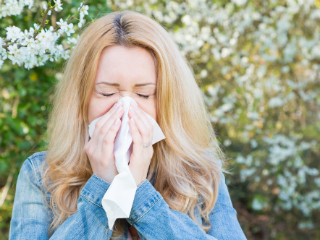 Spring has sprung across most of the country. Awesome, right? Not if you’ve got seasonal allergies. Anyone with a severe case of hay fever knows how horrible it is being outside on a windy otherwise beautiful spring day with pollen blowing and rapacious bees buzzing around. Your eyes water and swell up. Your nose congests, you go into mouth breather mode. Pressure headaches start. You can’t taste your food. You can’t really see through the tears and redness. Everything above the neck itches. Sneeze attacks seize you. You’re supposed to be in heaven. It’s all so lovely. Yet all that beauty, greenery, and life are lost on you. Spring is your enemy when you have hay fever.
Spring has sprung across most of the country. Awesome, right? Not if you’ve got seasonal allergies. Anyone with a severe case of hay fever knows how horrible it is being outside on a windy otherwise beautiful spring day with pollen blowing and rapacious bees buzzing around. Your eyes water and swell up. Your nose congests, you go into mouth breather mode. Pressure headaches start. You can’t taste your food. You can’t really see through the tears and redness. Everything above the neck itches. Sneeze attacks seize you. You’re supposed to be in heaven. It’s all so lovely. Yet all that beauty, greenery, and life are lost on you. Spring is your enemy when you have hay fever.
It’s bad enough as a city dweller who loves the outdoors. At least you’ve got somewhere to go to get away. Imagine you’re a hunter gatherer with hay fever. Your entire life occurs outside. There’s no “indoors.” Even your shelters blend seamlessly with nature. Your “work” is all outside. There’s no escaping the pollen, the environmental allergens, the seasons. And there’s no Benadryl or Claritin to mitigate the symptoms. Yeah, Grok would have really hurt if he had to deal with seasonal allergies.
So, did he?
First, why the hell do we get seasonal allergies, anyway?
Seasonal allergies occur when your innate immune system perceives airborne pollen as a threat and overreacts to its presence in your body with a flood of histamine, producing runny nose, itchy eyes, nasal congestion, sneezing, headaches, and other symptoms. This type of response makes sense with foreign substances that are intrinsically dangerous, like pathogenic microbes, poisons, and toxins, but there’s nothing inherently dangerous about pollen. What gives?
A long time ago, everyone had parasites—roundworms, hookworms, pigworms, and others. Heavy loads can cause serious nutrient deficiencies, anemia, stunted growth, impaired neurological development, but from studying modern populations who still carry parasites, we know that these bugs can also confer protection against autoimmune diseases, food allergies, and other immune-related conditions. In moderate doses, they tame overactive immune systems by giving them something to do. The constant presence of parasites keeps the immune system busy, and a busy immune system doesn’t have the time or energy to overreact to harmless intruders like egg whites. This is the basis for helminthic therapy, which I wrote about last year.
Pollen allergies are mediated by IgE, the very same antibody system that responds to parasites. Modern populations with high parasite loads tend to have lower rates of seasonal allergies. Modern populations without high parasite loads—like the people lucky enough to be reading this blog—tend to have higher rates of those conditions.
Some folks have more “active” immune systems based on genetics. Like the Neanderthals. Neanderthal coprolites show evidence of heavy parasite loads. Neanderthal DNA sequencing shows evidence of innate immunity genes meant to counter parasites. When ancient humans encountered Neanderthals and inter-bred, these immunity genes—which enhanced fitness in the new environment—introgressed into the offspring. Sure enough, populations with the most Neanderthal introgression, like folks of European and Asian descent, have the most hay fever. Their “enhanced” immunity doesn’t have enough to do in the modern sterile environment.
Though genes are a major determinant, they’re not the only one. Environment matters. Otherwise, people with the genetic propensity toward overactive immune responses to innocuous allergens like pollen would be sneezing from the womb. But they don’t. Sometimes those genes get expressed. Sometimes they don’t. They aren’t your destiny.
The sterility of your childhood environment plays a big role, with kids who grow up on farms tending to get lifelong protection from hay fever. Part of this is stems from exposure to pollen and other irritants (not to mention the microbes), but it could also be the “farm milk”; raw milk consumption is associated with protection against hay fever.
Vitamin D, one of the primary immune modulators, plays a role in allergy. Hay fever sufferers have lower vitamin D levels. One small study even showed improvement of hay fever symptoms with vitamin D supplementation.
Omega-3 status seems to matter. Higher EPA in RBCs and more ALA in the diet both reduce incidence among German adults, and in Japanese females, increased intake of fish fat reduces the incidence of hay fever.
Your gut health is likely important, as the gut influences everything. Food allergies and intolerances are well-known consequences of poor gut health and increased gut permeability, but those leaky guts may also allow non-food allergens into circulation to stimulate immune responses. There’s a lot of circumstantial evidence to suggest this is the case:
Certain probiotics have been shown to improve hay fever symptoms. Probiotics used in the studies include B. longum, B. lactis, L. paracasei, and L. acidophilus.
About a quarter of hay fever sufferers also have food allergies.
Irritable bowel syndrome frequently accompanies or even predicts hay fever, though it most likely doesn’t cause it.
Anecdotally, folks who give up grains and other gut irritants often report their hay fever stops.
Quercetin, a natural antihistamine that can reduce histamine release and improve hay fever symptoms, also improves intestinal permeability.
We’d need further research, but it looks promising to me.
Introducing small amounts of pollen through the consumption of raw local honey can improve allergic sensitization and reduce hay fever symptoms. But it has to be the pollen you’re actually allergic to. Researchers found that eating birch pollen honey before the season commenced reduced birch pollen allergy symptoms and resulted in less usage of antihistamines when compared to eating preseasonal non-birch pollen honey.
Stress could worsen hay fever. According to research, hay fever sufferers with the worst symptoms are most likely to report being “stressed.” Those who are “relaxed” tend to have milder symptoms. The causation could be reversed, of course, with severe hay fever causing increased stress. Or it could be circular, with stress levels and hay fever severity both feeding each other. After all, we know that stress makes gut health worse.
In fact, one of the most frequently-reported benefits of going Primal is the cessation of seasonal allergies. They drop grains, improve their gut health, eat more fish and less omega-6, take probiotics or eat fermented food, start getting some sun, realize the value of nature and spend more time outdoors being exposed to pollen and other seasonal allergens, and things change. Their noses clear up. Their eyes stop itching. Eventually, the pollen doesn’t bother them so much. Spring becomes a friend, not a foe. Most people discount the impact of hay fever, but it can really detract from your quality of life. It’s a biggie.
To answer the question, Grok certainly had the genetic potential for hay fever. But several factors, including parasite load, gut health, sun exposure, dirt exposure, diet (including omega-3 and honey intake), and a relatively low-stress lifestyle probably meant he wasn’t sneezing, coughing, and mouth-breathing up a storm. His immune system had better things to do than freak out about a little birch pollen.
Thanks for reading, everyone. How has going Primal affected your seasonal allergies?
Prefer listening to reading? Get an audio recording of this blog post, and subscribe to the Primal Blueprint Podcast on iTunes for instant access to all past, present and future episodes here.
Like This Blog Post? Subscribe to the Mark's Daily Apple Newsletter and Get 10 eBooks and More Delivered to Your Inbox for FREE






Did Grok Suffer From Seasonal Allergies?
 Spring has sprung across most of the country. Awesome, right? Not if you’ve got seasonal allergies. Anyone with a severe case of hay fever knows how horrible it is being outside on a windy otherwise beautiful spring day with pollen blowing and rapacious bees buzzing around. Your eyes water and swell up. Your nose congests, you go into mouth breather mode. Pressure headaches start. You can’t taste your food. You can’t really see through the tears and redness. Everything above the neck itches. Sneeze attacks seize you. You’re supposed to be in heaven. It’s all so lovely. Yet all that beauty, greenery, and life are lost on you. Spring is your enemy when you have hay fever.
Spring has sprung across most of the country. Awesome, right? Not if you’ve got seasonal allergies. Anyone with a severe case of hay fever knows how horrible it is being outside on a windy otherwise beautiful spring day with pollen blowing and rapacious bees buzzing around. Your eyes water and swell up. Your nose congests, you go into mouth breather mode. Pressure headaches start. You can’t taste your food. You can’t really see through the tears and redness. Everything above the neck itches. Sneeze attacks seize you. You’re supposed to be in heaven. It’s all so lovely. Yet all that beauty, greenery, and life are lost on you. Spring is your enemy when you have hay fever.
It’s bad enough as a city dweller who loves the outdoors. At least you’ve got somewhere to go to get away. Imagine you’re a hunter gatherer with hay fever. Your entire life occurs outside. There’s no “indoors.” Even your shelters blend seamlessly with nature. Your “work” is all outside. There’s no escaping the pollen, the environmental allergens, the seasons. And there’s no Benadryl or Claritin to mitigate the symptoms. Yeah, Grok would have really hurt if he had to deal with seasonal allergies.
So, did he?
First, why the hell do we get seasonal allergies, anyway?
Seasonal allergies occur when your innate immune system perceives airborne pollen as a threat and overreacts to its presence in your body with a flood of histamine, producing runny nose, itchy eyes, nasal congestion, sneezing, headaches, and other symptoms. This type of response makes sense with foreign substances that are intrinsically dangerous, like pathogenic microbes, poisons, and toxins, but there’s nothing inherently dangerous about pollen. What gives?
A long time ago, everyone had parasites—roundworms, hookworms, pigworms, and others. Heavy loads can cause serious nutrient deficiencies, anemia, stunted growth, impaired neurological development, but from studying modern populations who still carry parasites, we know that these bugs can also confer protection against autoimmune diseases, food allergies, and other immune-related conditions. In moderate doses, they tame overactive immune systems by giving them something to do. The constant presence of parasites keeps the immune system busy, and a busy immune system doesn’t have the time or energy to overreact to harmless intruders like egg whites. This is the basis for helminthic therapy, which I wrote about last year.
Pollen allergies are mediated by IgE, the very same antibody system that responds to parasites. Modern populations with high parasite loads tend to have lower rates of seasonal allergies. Modern populations without high parasite loads—like the people lucky enough to be reading this blog—tend to have higher rates of those conditions.
Some folks have more “active” immune systems based on genetics. Like the Neanderthals. Neanderthal coprolites show evidence of heavy parasite loads. Neanderthal DNA sequencing shows evidence of innate immunity genes meant to counter parasites. When ancient humans encountered Neanderthals and inter-bred, these immunity genes—which enhanced fitness in the new environment—introgressed into the offspring. Sure enough, populations with the most Neanderthal introgression, like folks of European and Asian descent, have the most hay fever. Their “enhanced” immunity doesn’t have enough to do in the modern sterile environment.
Though genes are a major determinant, they’re not the only one. Environment matters. Otherwise, people with the genetic propensity toward overactive immune responses to innocuous allergens like pollen would be sneezing from the womb. But they don’t. Sometimes those genes get expressed. Sometimes they don’t. They aren’t your destiny.
The sterility of your childhood environment plays a big role, with kids who grow up on farms tending to get lifelong protection from hay fever. Part of this is stems from exposure to pollen and other irritants (not to mention the microbes), but it could also be the “farm milk”; raw milk consumption is associated with protection against hay fever.
Vitamin D, one of the primary immune modulators, plays a role in allergy. Hay fever sufferers have lower vitamin D levels. One small study even showed improvement of hay fever symptoms with vitamin D supplementation.
Omega-3 status seems to matter. Higher EPA in RBCs and more ALA in the diet both reduce incidence among German adults, and in Japanese females, increased intake of fish fat reduces the incidence of hay fever.
Your gut health is likely important, as the gut influences everything. Food allergies and intolerances are well-known consequences of poor gut health and increased gut permeability, but those leaky guts may also allow non-food allergens into circulation to stimulate immune responses. There’s a lot of circumstantial evidence to suggest this is the case:
Certain probiotics have been shown to improve hay fever symptoms. Probiotics used in the studies include B. longum, B. lactis, L. paracasei, and L. acidophilus.
About a quarter of hay fever sufferers also have food allergies.
Irritable bowel syndrome frequently accompanies or even predicts hay fever, though it most likely doesn’t cause it.
Anecdotally, folks who give up grains and other gut irritants often report their hay fever stops.
Quercetin, a natural antihistamine that can reduce histamine release and improve hay fever symptoms, also improves intestinal permeability.
We’d need further research, but it looks promising to me.
Introducing small amounts of pollen through the consumption of raw local honey can improve allergic sensitization and reduce hay fever symptoms. But it has to be the pollen you’re actually allergic to. Researchers found that eating birch pollen honey before the season commenced reduced birch pollen allergy symptoms and resulted in less usage of antihistamines when compared to eating preseasonal non-birch pollen honey.
Stress could worsen hay fever. According to research, hay fever sufferers with the worst symptoms are most likely to report being “stressed.” Those who are “relaxed” tend to have milder symptoms. The causation could be reversed, of course, with severe hay fever causing increased stress. Or it could be circular, with stress levels and hay fever severity both feeding each other. After all, we know that stress makes gut health worse.
In fact, one of the most frequently-reported benefits of going Primal is the cessation of seasonal allergies. They drop grains, improve their gut health, eat more fish and less omega-6, take probiotics or eat fermented food, start getting some sun, realize the value of nature and spend more time outdoors being exposed to pollen and other seasonal allergens, and things change. Their noses clear up. Their eyes stop itching. Eventually, the pollen doesn’t bother them so much. Spring becomes a friend, not a foe. Most people discount the impact of hay fever, but it can really detract from your quality of life. It’s a biggie.
To answer the question, Grok certainly had the genetic potential for hay fever. But several factors, including parasite load, gut health, sun exposure, dirt exposure, diet (including omega-3 and honey intake), and a relatively low-stress lifestyle probably meant he wasn’t sneezing, coughing, and mouth-breathing up a storm. His immune system had better things to do than freak out about a little birch pollen.
Thanks for reading, everyone. How has going Primal affected your seasonal allergies?




Limited Time Only: Win the Ultimate PRIMAL KITCHEN™ Prize Package!
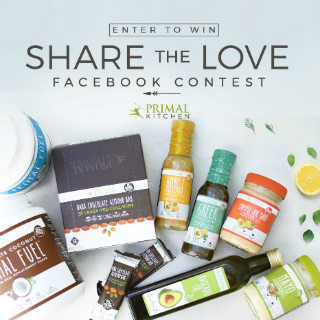 We have a hot contest running right now and it only takes a second to enter. All you have to do is follow the instructions here, “like” the Primal Kitchen Facebook Page and leave a comment. This is a great opportunity to tell us what you think about the whole Primal Kitchen endeavor. You could mention your favorite Primal Kitchen product, what you like about our healthy ingredient profiles, your favorite Primal Kitchen recipe, what you’d love to see from Primal Kitchen in the future…just go crazy!
We have a hot contest running right now and it only takes a second to enter. All you have to do is follow the instructions here, “like” the Primal Kitchen Facebook Page and leave a comment. This is a great opportunity to tell us what you think about the whole Primal Kitchen endeavor. You could mention your favorite Primal Kitchen product, what you like about our healthy ingredient profiles, your favorite Primal Kitchen recipe, what you’d love to see from Primal Kitchen in the future…just go crazy!
Now’s not only a great opportunity to let Primal Kitchen feel the love—it’s your chance to win a killer prize package for doing so. Once you take a moment to “like” the Primal Kitchen Facebook page and leave a comment, you’ll be in the running to win the whole kitten kaboodle of Primal Kitchen products (over $150 value!), comprising:
12-Pack of PRIMAL KITCHEN™ Dark Chocolate Almond Bars
PRIMAL KITCHEN™ Mayo
PRIMAL KITCHEN™ Chipotle Lime Mayo
PRIMAL KITCHEN™ Avocado Oil
PRIMAL KITCHEN™ Greek Vinaigrette
PRIMAL KITCHEN™ Honey Mustard Vinaigrette
Chocolate Coconut Primal Fuel
Vanilla Coconut Primal Fuel
Click here for your chance to win the ultimate PRIMAL KITCHEN™ prize package.
Don’t wait if you want to win…the contest ends May 18th at midnight!
Good luck!




May 9, 2016
Dear Mark: Lead in Bone Broth, Cooked and Cooled Potatoes, and Stress Strategies
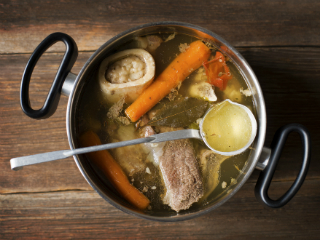 For today’s edition of Dear Mark, I’m answering three questions. First one concerns the lead content in bone broth. A 2013 study reported elevated levels of lead in chicken bone broth. And not the canned or boxed stuff, but the real thing: broth made from actual chicken bits. Should you worry? Second, do cooked and cooled potatoes really make the carbs less problematic for people who typically try to avoid them? How and why should people who otherwise avoid potatoes consider eating cooked and cooled ones? And finally, do I have any good, simple strategies for dealing with stress? Why yes, yes I do.
For today’s edition of Dear Mark, I’m answering three questions. First one concerns the lead content in bone broth. A 2013 study reported elevated levels of lead in chicken bone broth. And not the canned or boxed stuff, but the real thing: broth made from actual chicken bits. Should you worry? Second, do cooked and cooled potatoes really make the carbs less problematic for people who typically try to avoid them? How and why should people who otherwise avoid potatoes consider eating cooked and cooled ones? And finally, do I have any good, simple strategies for dealing with stress? Why yes, yes I do.
Let’s go:
Is anyone concerned about the amount of lead in bone broth? I love bone broth, but now wondering…
I’m not too worried.
That study had some limitations, which the Weston A Price Foundation covered pretty well. Ignore the meandering quasi-conspiratorial tangents and focus on the relevant points.
It tested broth from just one group of chickens. There was no real control group. They tested broth made from bones, broth made from meat, broth made from skin and cartilage, and plain tap water, but everything came from the same farm using the same chickens raised under the same. Since lead comes from the environment, the feed, the water. We already know that lead accumulates in the bones. What matters is how much lead the animals you’re using to make broth are exposed to throughout their lives. I’d like to see a comparison between chicken broths made from animals from different farms and environments.
Most of the lead was in the skin of the chickens. Why? Even though lead accumulates primarily in the bones, not the skin and cartilage, the skin and cartilage broth had the most lead. This indicates something weird was going on with these chickens. Cartilage receives very little to no blood flow, so it probably didn’t contribute much if any lead. That leaves the skin. How would so much lead get into the skin when we know that most consumed/absorbed lead ends up in the bones? Well, chickens are suckers for a good dirt bath. If they have access to it, they’re constantly scrounging, rolling, and “dusting” around in the dirt. Dirt readily accumulates lead from car exhaust and lead-based paint. If a chicken’s rolling around in lead-contaminated soil, they’re getting lead all over their skin and that lead will end up in your broth.
The animals’ environments and upbringing are everything. The WAPF describes a follow-up study into two broths made from grass-fed beef bones and pasture-raised chicken bones that was unable to detect any lead in either. This despite the chickens having plenty of access to dirt and all the same dirt-dusting proclivities their kind is known for.
I wouldn’t worry too much, but I would be serious about where I get my bones and/or broth.
Dear mark,
I can’t find the answer to this question anywhere on your site, although I’ve tried for countless hours. How much cooked and cooled potatoes can I safely eat and still stay within the weight loss/maintenance part of your carb curve? In other words, how much RS potato salad CAN I have without a glucose spike?
Thanks for your help,
Jen
Cooking and cooling a potato doesn’t erase its digestible carb content, nor does it eliminate the glucose spike you get from eating it. It just makes it a little less glycemic and feeds your gut bugs. It’s a “lower” carb way to eat potatoes. You can get away with more of them.
A new study examined the effects of cooking and cooling a dozen or so varieties of potato.
Estimated glycemic response was reduced by 10-15% across the board after cooling the cooked potatoes. I say “estimated” because they didn’t actually feed the potatoes to anyone. They dissected and tested samples from each potato for resistant starch, fiber, and digestible starch after different cooking methods and found the more RS and fiber, the lower the estimated glucose response.
But I think actual cooled potatoes will help even more than the estimates in actual humans. For one, you’ve got the lower glycemic response due to reduced digestible carbohydrate. Fewer carbs to digest, less glucose to reach the blood.
Two, you’ve got the insulin-sensitizing effect of consuming resistant starch. RS improves insulin sensitivity, even in people with metabolic syndrome, and makes glucose less of a problem.
Three, resistant starch seems to induce satiety, thereby leading to less hunger and calorie intake. In a recent human study, a large dose of resistant starch increased satiety and decreased subsequent food intake. You eat less food, you’ll have a better glucose response.
Four, resistant starch even improves fasting blood glucose, an indication of extended—not just short term—benefits to glucose tolerance and control.
I don’t have any hard numbers for you because every potato is different. But it appears you can count on at the very least a 10-15% reduction in postprandial glucose (and likely more).
I have such a hard time managing my anxiety/stress. I am in counseling now, but I was wondering if anyone could share any personal techniques that they find soothing or calming. Really, anything you do that helps you de-stress would be great to hear! Thanks all. Stay well!
I’ve been in the same boat for most of my life. Handling stress just doesn’t come naturally to me. I have some more involved methods for dealing with stress, like paddle boarding or dropping everything for a day to just take a break, but physical movement is the simplest, easiest tool I have.
Movement is my go-to. It’s healthy—you’re not stuffing your face with something sweet and regretting it a minute later or lighting a cigarette or taking a shot of whiskey. It’s productive—you’re getting an essential aspect of a healthy day out of the way. It’s engaging—you can’t help but focus on how your body’s navigating through space.
If I’m stuck on a post or paragraph and I can’t quite seem to get over writer’s block, I’ll hop on the slackline out back and go for a few minutes. This demands my close attention to the moment, so I can’t think about the work I’m not doing. Then I head back in and suddenly words flow. With writer’s block, my main problem is that I’m thinking too much about the writing. I actually need to take a break and think about something else. You can’t brute force your way past.
For general stress, I’ll just go for a walk. Even if there’s resistance, I push through it. If I can make it through the first three minutes, everything falls into place and the stress melts away. I’ll even sometimes take those stressful business calls on a walk with me. Just say “hold on a sec,” head out the door, and continue the phone conversation as I walk.
One of my secret visions/hopes for the near future is the ability to write and edit content while walking, probably through some neural/eyewear/augmented reality interface. Like having a document projected into the world that you can edit with your mind. One day.
Okay, that’s it for today.
How do you guys deal with stress in the moment?
Do cooked and cooled potatoes feature in your diet?
What do you think about lead in broth?
Thanks for reading!




Mark Sisson's Blog
- Mark Sisson's profile
- 199 followers



